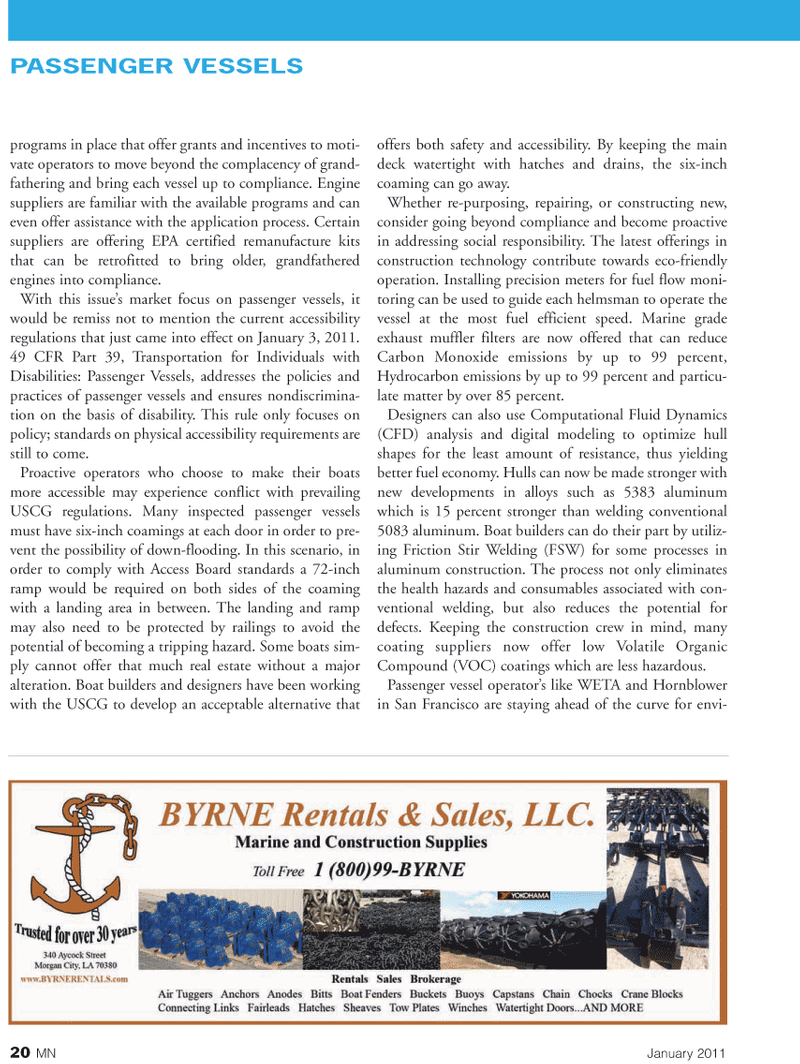
Page 20: of Marine News Magazine (January 2011)
Vessel Construction & Repair
Read this page in Pdf, Flash or Html5 edition of January 2011 Marine News Magazine
20 MN January 2011 programs in place that offer grants and incentives to moti- vate operators to move beyond the complacency of grand- fathering and bring each vessel up to compliance. Engine suppliers are familiar with the available programs and can even offer assistance with the application process. Certain suppliers are offering EPA certified remanufacture kits that can be retrofitted to bring older, grandfathered engines into compliance.
With this issue’s market focus on passenger vessels, it would be remiss not to mention the current accessibility regulations that just came into effect on January 3, 2011. 49 CFR Part 39, Transportation for Individuals with
Disabilities: Passenger Vessels, addresses the policies and practices of passenger vessels and ensures nondiscrimina- tion on the basis of disability. This rule only focuses on policy; standards on physical accessibility requirements are still to come.
Proactive operators who choose to make their boats more accessible may experience conflict with prevailing
USCG regulations. Many inspected passenger vessels must have six-inch coamings at each door in order to pre- vent the possibility of down-flooding. In this scenario, in order to comply with Access Board standards a 72-inch ramp would be required on both sides of the coaming with a landing area in between. The landing and ramp may also need to be protected by railings to avoid the potential of becoming a tripping hazard. Some boats sim- ply cannot offer that much real estate without a major alteration. Boat builders and designers have been working with the USCG to develop an acceptable alternative that offers both safety and accessibility. By keeping the main deck watertight with hatches and drains, the six-inch coaming can go away.
Whether re-purposing, repairing, or constructing new, consider going beyond compliance and become proactive in addressing social responsibility. The latest offerings in construction technology contribute towards eco-friendly operation. Installing precision meters for fuel flow moni- toring can be used to guide each helmsman to operate the vessel at the most fuel efficient speed. Marine grade exhaust muffler filters are now offered that can reduce
Carbon Monoxide emissions by up to 99 percent,
Hydrocarbon emissions by up to 99 percent and particu- late matter by over 85 percent.
Designers can also use Computational Fluid Dynamics (CFD) analysis and digital modeling to optimize hull shapes for the least amount of resistance, thus yielding better fuel economy. Hulls can now be made stronger with new developments in alloys such as 5383 aluminum which is 15 percent stronger than welding conventional 5083 aluminum. Boat builders can do their part by utiliz- ing Friction Stir Welding (FSW) for some processes in aluminum construction. The process not only eliminates the health hazards and consumables associated with con- ventional welding, but also reduces the potential for defects. Keeping the construction crew in mind, many coating suppliers now offer low Volatile Organic
Compound (VOC) coatings which are less hazardous.
Passenger vessel operator’s like WETA and Hornblower in San Francisco are staying ahead of the curve for envi-
PASSENGER VESSELS

 19
19

 21
21
